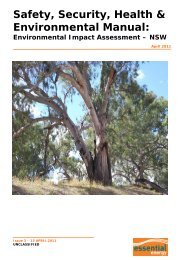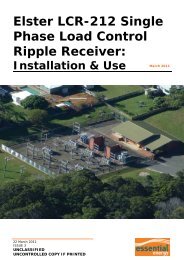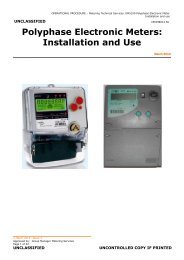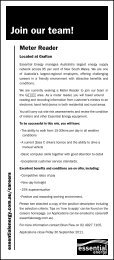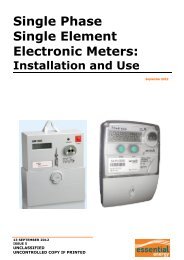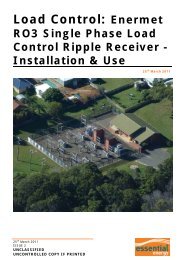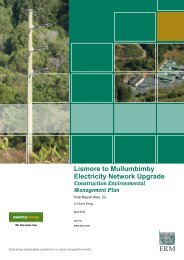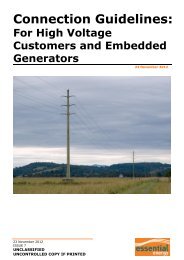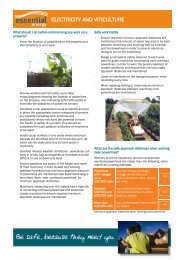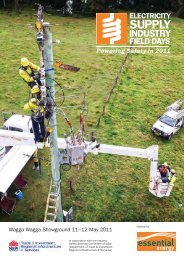Full Version - Essential Energy
Full Version - Essential Energy
Full Version - Essential Energy
You also want an ePaper? Increase the reach of your titles
YUMPU automatically turns print PDFs into web optimized ePapers that Google loves.
Notes to the Financial Statements<br />
for the year ended 30 June 2005<br />
Notes to tables above<br />
1. AASB 119: Employee Benefits requires a recalculation of defined benefit scheme assets, based on the government bond rate at each<br />
reporting date rather than the long term expected rate of return on the plan assets. Country <strong>Energy</strong> contributes to four defined benefit<br />
plans and the value of the adjustment disclosed in the table represents the aggregate of the recalculated balances. The superannuation<br />
position has moved from a net asset to a net liability position.<br />
2. AASB 139: Financial Instruments: Recognition & Measurement: requires that ‘available-for-sale financial assets’ be recognised at fair<br />
value. Country <strong>Energy</strong>’s joint venture investment in the Wind Farm (refer note 30) falls under the definition and as a consequence the<br />
investment has been reclassified from property, plant and equipment to investments. The requirement to disclosure the asset at fair<br />
value results in a write back of accumulated depreciation.<br />
3. Goodwill is not amortised under AEIFRS but is tested for impairment annually. AASB 1 provides that previously amortised goodwill is<br />
not recapitalised. The adjustment as at 30 June 2005 reverses the goodwill charge recognised under AGAAP for the current year.<br />
4. UIG 1017: Developer & Customer Contributions for Construction in a Price Regulated Market: requires developer & customer<br />
contributions (capital contributions) to be recognised when the asset is completed in accordance with the term and conditions of the<br />
contribution. Contributions must be recognised at fair value. The opening balances have been adjusted to ensure that they represent<br />
only revenue receivable (asset) or revenue prepaid (liability), in accordance with the standard.<br />
5. UIG 3: Emission Right states that for traded emission rights, the entity’s allowance to rights should be recognised as an intangible<br />
asset under AAS138: Intangible Assets, and that the obligation to surrender allowances should be recognised as a liability. Country<br />
<strong>Energy</strong> trades Renewable <strong>Energy</strong> Certificates (RECs) and NSW Greenhouse Abatement Certificates (NGACs) both of which fall under<br />
the standard’s definition of intangible assets. As at 1 July 2004 the number of certificates held was less than the number required to be<br />
surrendered, therefore a net liability existed. The value of this liability is disclosed separately for each type of certificate. As at 30 June<br />
2005, Country <strong>Energy</strong> held surplus of RECs at market value relative to the target to surrender.<br />
A net liability position existed for NGACs as the market value of NGACs at balance date had increased.<br />
71<br />
6. A deferred taxation asset arises with the recognition of the net superannuation liability. In this case Country <strong>Energy</strong> expects that future<br />
contributions will be deductible for tax. The tax effect is calculated at 30% of the reduction in liability of $0.605 million<br />
7. AASB 112: Income Taxes requires a balance sheet approach to tax effect accounting. The net book value of pre-June 2002 capital<br />
contributions of $196.520 million are considered to have no tax base. On transition to AEIFRS, the difference between the accounting<br />
base and the tax base will give rise to a deferred tax liability. The liability is estimated to be $58.955 million at a tax rate of 30%.<br />
8. A deferred taxation asset also arises from the derecognition of capital contributions. The tax effect is calculated at 30% of the $36.673<br />
million deferred income noted in item 4.<br />
9. A deferred tax asset arises as there will be a tax deduction for the purchases of RECs and NGACs in the period to 31 December 2004<br />
(refer item 5).<br />
10. A deferred taxation liability also arises from the assets revalued by the former distributor NorthPower (refer note 19). The liability has<br />
been calculated at 30% of the $313.270 million difference between the tax value and carrying value.<br />
(ii) Financial Instruments<br />
In accordance with NSW Treasury’s indicative mandates, Country <strong>Energy</strong> will apply the exemption provided in AASB 1 First-time<br />
Adoption of Australian Equivalents to International Financial Reporting Standards not to apply the requirements of AASB 132<br />
and AASB 139 for the financial year ended 30 June 2005.These standards will apply from 1 July 2005. None of the information<br />
provided in the preceding table includes any impacts for financial instruments. However when these Standards are applied, they<br />
are likely to impact on retained earnings (on first adoption) and the amount of volatility of profit. Further, the impact of these<br />
Standards will in part depend on whether the fair value option can or will be mandated consistent with Government Finance<br />
Statistics.<br />
(f) Recognition of Revenue<br />
Revenue relating to Country <strong>Energy</strong>’s core operations is classified as revenue from operating activities for the purposes of note 2.<br />
All other revenue is classified as revenue outside operating activities for the purposes of note 2.<br />
(i) Sales revenue<br />
Sales revenue comprises revenue earned (net of returns, discounts and allowances) from the provision of products or services and<br />
is recognised when the goods are provided or when the fee in respect of services provided is receivable.<br />
(ii) Revenue from unread meters<br />
Revenue from unread meters is calculated at balance date for those customers who at balance date, did not have their meters<br />
read and invoiced. The calculation is based on their estimated consumption. A change in the method of estimation of this item has<br />
led to an additional $5.146 million being recognised in the current reporting period.<br />
(iii) Interest income<br />
Interest income is recognised on an accrual basis using the interest applicable to the financial asset.<br />
COUNTRY ENERGY ANNUAL REPORT 2004–2005




